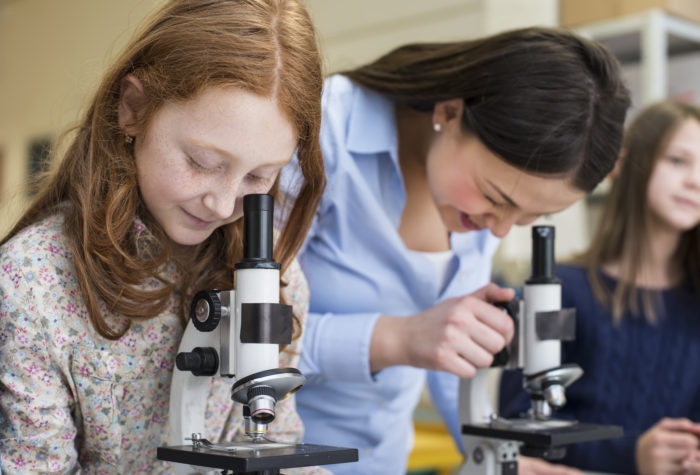With demand for well-trained STEM (science, technology, engineering and math) workers expected to skyrocket, and women and people of color grossly underrepresented in STEM professions, afterschool programs in Kentucky and across the country can play a critical role in preparing the workforce of the future. Today, 53% of Kentucky parents report programs are providing STEM, a drop from 72% in 2014. Sixty percent of parents nationally and 67% in Kentucky report that their child participates in STEM in afterschool twice or more per week. Learning opportunities in each of the STEM disciplines – science learning, technology and engineering, and math – are more available in afterschool programs nationwide today than they were in 2014. Two in five parents across the country (41%) report that their child’s afterschool program offers computer science opportunities – a question asked for the first time in this survey.
Those are among the findings from STEM Learning in Afterschool on the Rise, But Barriers and Inequities Exist, a household survey conducted by Edge Research for the Afterschool Alliance and released today. In total, 42,071 Kentucky students and 5,740,836 students nationwide are getting STEM learning opportunities in their afterschool programs.
But while afterschool programs are reaching populations underrepresented in STEM fields, including Black and Latinx students, students from low-income families are much less likely to be getting technology/engineering and computer science activities in afterschool than students from higher-income families nationwide. That may be, in part, due to cost; parents across the country report the mean cost of programs offering STEM learning is $107 per week, compared to $74 per week for programs that do not offer it.
“Afterschool programs are uniquely positioned to provide the STEM learning opportunities students need to succeed in school and in life,” said Afterschool Alliance Executive Director Jodi Grant. “Thanks to the team-based, hands-on learning these programs provide, they have become a cornerstone of STEM learning for children and youth from all backgrounds. But the inequities are troubling. We need to build more partnerships and invest more resources to ensure that all students, no matter their family income, gender, or race, can access STEM in afterschool. And we need to increase access to afterschool overall, because even though a greater percentage of programs are providing STEM, fewer children are in afterschool programs today than in years past. That trend is alarming.”
“Our programs here in Kentucky have been doing heroic work during the pandemic, helping students who have suffered more than a year of isolation, learning loss, and trauma,” said Tom Haggard, Director of the Kentucky Out-of-School Alliance. “Many programs provided STEM learning before and during the pandemic. We are pleased to see that a growing number of parents recognize the importance of STEM learning in afterschool, but we also recognize that we have more work to do. We are determined to find ways to increase resources and engage new partners so that all Kentucky families have the afterschool programs they need and all children and youth get STEM in their afterschool programs.”
STEM Learning in Afterschool is based on responses from more than 31,000 U.S. families, including 586 families in Kentucky. It includes national-level findings from smaller surveys of parents and program providers conducted in summer and fall of 2020 and spring of 2021. In important respects, Kentucky results mirror the national survey findings, which include:
- Parents strongly support STEM learning in afterschool. Three out of four parents nationally, and 72% in Kentucky say that afterschool programs help children gain interest and skills related to STEM. Seventy-two percent of parents across the country say STEM and computer science learning opportunities were important in choosing an afterschool program for their child, up from 53% in 2014. In Kentucky, 62% of parents say that today.
- STEM learning opportunities are widely available in afterschool and summer learning programs. Today, nationally, 73% of parents report that their child’s afterschool program offers STEM learning opportunities, up from 69% in 2014. Among the STEM disciplines, the greatest jump is in technology/engineering activities, which were offered by 30% of afterschool programs in 2014 and 39% today. Nearly 2 million U.S. children (1,904,846) participated in summer STEM camps in 2019, including 11,013 children in Kentucky.
- Afterschool programs provide STEM learning opportunities to populations underrepresented in STEM fields. Nationally, more parents of Black (77%) and Latinx (77%) students report that their child’s afterschool program offers STEM than White (72%) and Asian (68%) parents. Afterschool STEM opportunities have increased for both boys and girls since 2014, rising from 69% in 2014 to 75% for boys and 72% for girls today.
- But opportunities are not the same for all families. Nationally, three in five children in families with higher incomes (62%) participate in a STEM activity in their afterschool program twice per week or more, but just 56% of children in families with low incomes do. Students in families with higher incomes also have a greater variety of STEM offerings, particularly in technology/engineering, science, and computer science.
- There are gender disparities in the students afterschool and summer learning programs reach with STEM. Although afterschool STEM opportunities have increased for both boys and girls, opportunities are growing faster for boys. Nationally, STEM learning opportunities in afterschool increased from 69% in 2014 to 75% for boys, while increasing from 69% to 72% for girls. Nationally, 53% of STEM summer camp participants are boys and just 47% are girls.
Kentucky America After 3PM reports, and accompanying data, are available at aa3pm.co/ky-stem.
This 2021 America After 3PM special report, STEM Learning in Afterschool, is based on research commissioned and funded by Overdeck Family Foundation. Data from this special report is based on the 2020 America After 3PM survey results, which was made possible with support from the New York Life Foundation, Overdeck Family Foundation, The Wallace Foundation, the S.D. Bechtel, Jr. Foundation, Altria Group, and the Walton Family Foundation, as well as the Charles Stewart Mott Foundation.

